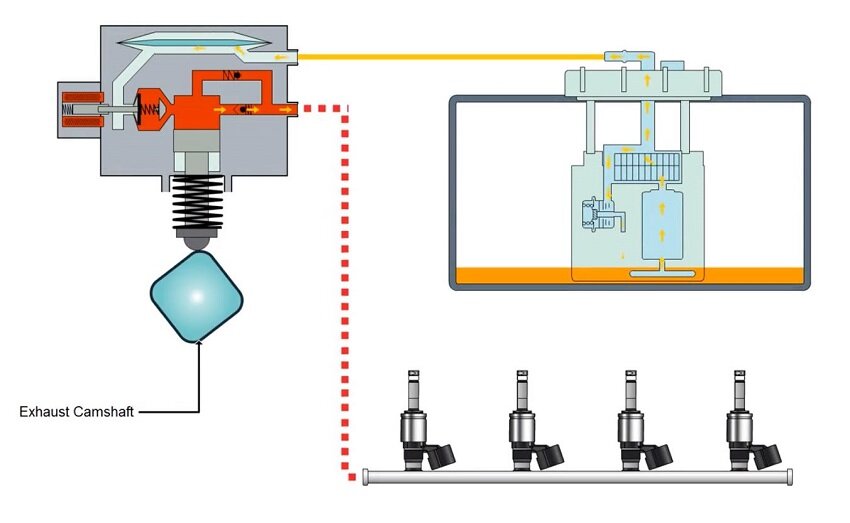Gasoline Direct Injection 101; How Your Civic Gets Fuel
Hey, 27WON fam! In today’s tech blog we are going to give you the 101 intro into your 10th and 11th Gen Honda Civics’ fuel system. We'll break down what port fuel injection is (the type of fuel delivery on your older Hondas and Acuras’ like the RSX and S2000) and what gasoline direct injection (GDI) is. We’ll also discuss how the GDI system operates in your late model Honda so stick with us!
Air, fuel, and spark, are the 3 key ingredients to a complete combustion cycle in your engine. Understanding how the fuel system works in your CivicX and AccordX will help you mod safely. Let’s dive right in and learn some cool stuff.
When it comes to fuel delivery for your late model Honda there are two types of systems in use; Multi-Port Fuel Injection (MFPI) (Pre 2016) and Gasoline Direct Injection (Post 2016).
MPFI is a system that consists of a low-pressure in-tank fuel pump, a common fuel rail housing, steel lines, rubber hoses, and a predetermined set of injectors. In our Civic’s case, 4 injectors. These comprise the transport system to get gasoline from the fuel tank to the cylinders and back if necessary.
In this traditional system, the low-pressure fuel pump in the gas tank pumps cool fuel at roughly 40-60 psi and sends it through dedicated fuel lines all the way up to the engine bay. Once in the engine bay the fuel is routed through a pressurized fuel rail where the fuel is then run through one of the 4 fuel injectors at the right time and in the right quantity. When the appropriate cylinder is in the correct spot in its 4-stroke cycle, the ECU will open up the injector and fuel will spray into our intake manifold. The pressure difference that exists between the fuel rail and the intake manifold is what pulls the fuel through. Precise electronics are what make sure the right amount of fuel comes out. The ECU controls the opening and closing of each injector. Boom! We have the power we need.
Image by Bosch Mobility Solutions via YouTube
Now let’s look at the components that make up a GDI system. We still have a low-pressure in-tank fuel pump, a common fuel rail with a set of 4 injectors (in the case of the Honda Civic), the dedicated fuel lines, and hoses that move our fuel around. There is an additional piece of hardware for GDI; a second high-pressure fuel pump. This second fuel pump is attached directly to our cylinder head and driven by the camshaft.
GDI HPFP, Low pressure in tank pump, and SS fuel Lines for the FK8 Honda Civic Type R
The process starts the same with the low-pressure in-tank pump churning out 40-60 psi and getting fuel to our engine bay. However, instead of feeding straight into a fuel rail like MFPI it feeds the second high-pressure fuel pump. This camshaft driven pump takes the pressure of the gas from 40-60 psi to upwards of 2000psi. This very highly pressurized gas goes to the fuel rail and on to the injectors. But these injectors are different, they are no longer spraying the fuel into the intake manifold but rather spraying the fuel “directly” into each individual cylinder. Hence the name direct injection.
Image by Bosch Mobility Solutions via YouTube
As you just read, the key difference between the MPFI and GDI systems is the location at which the injectors introduce fuel for our combustion chamber.
Check out this diagram of how the fuel flows in your L15 SI or K20 FK8
Image by Honda North America
You can see in the GDI diagram above that fuel is picked up from a low-pressure in-tank pump and then travels to the high-pressure fuel pump or HPFP for short.
In this next diagram, you can see how the intake camshaft drives the HPFP to increase the fuel pressure before sending it to the fuel rail and injectors. This step is crucial since we want to spray the fuel directly into the cylinders. The pressure of the fuel needs to be greater than that of the cylinder or otherwise the fuel won’t flow.
Image by Honda North America
So why does your 2019 Civic Hatchback Sport have GDI but your older brother's 2001 Acura Integra does not? The simple answer is emissions and increased MPG. With a GDI system, the amount of fuel delivered is much more precise and thus less fuel wasted. In a world with ever-tightening emissions standards, OEM manufacturers need to do everything they can to squeeze out lower emissions and higher MPG’s.
I hope this blog was easy to understand and is useful to you. If you liked it and want to see a 201 where we go into the challenges of upgrading the fuel system then drop us a comment below.
Till next time
REDEFINE the Aftermarket
-Vincent






